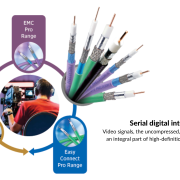SDI – How Far Can You Run?
Serial digital interface (SDI) video signals, the uncompressed, unencrypted digital signals that were developed by SMPTE (the Society of Motion Picture Television Engineers), an integral part of high-definition broadcast transmissions.
Although fiber is an option, most SDI signals use a 75 Ohm coax, an industry staple in broadcast for many years. Coax has a proven track record of reliability and is easy to terminate and install, with excellent electrical characteristics that offer very good performance.
As more and more coax cables for SDI signals hit the market, broadcasters need to determine how long they can run these cables and their camera systems. To give broadcasters the info they need, Belden have created a table based on signal loss recommendations for given formats as specified by SMPTE, an updated table that features the new formats, the new versions of cables, and their maximum recommended transmission distances.
It is however important to note the bit error rate (BER) can vary dramatically as the calculated distances are approached. BER is dependent on receiver design and the losses of the actual coax used. OEM specifications should be consulted to verify their maximum recommended transmission as performance can vary based on the type of active equipment specified. Some manufacturers aren’t designing all their 12 GHz receivers to reach the maximum loss level, which could result in distance reductions of up to 50%. This variance is recognized in the SMPTE 2082-1 Standard, however, receivers designed to work with greater or lesser signal attenuation are acceptable.
The table is based on attenuation or signal loss at one-half the signal frequency as defined by SMPTE and based on signal type. The distance values are for cables only; they don’t include connectors, bulkheads or other items used to connect cables and add loss.
Video Distance Chart – https://www.jaycor.co.za/wp-content/uploads/2022/05/digital-video-distance-chart-product-bulletin.pdf
As the industry continues to move towards 12 Gb/s single-link as part of SMPTE 2082-1, it’s now critical for designers to verify distance. To do this, check with your equipment manufacturers to confirm the type of cable needed to reach the distance you want to meet. To support 12G-SDI Belden created a new series of coax cables specifically for 12 GHz bandwidth. Belden’s 4K UHD Coax Cable for 12G-SDI supports 4K content without a change to fiber. It gives designers access to the best possible performance in a coax cable sweep tested to 12 GHz signal.
While some broadcasters have switched to fiber optic cabling to achieve greater distances (JAYCOR supports these cables too), coax cable isn’t dead. In fact, there are many applications where coax is still preferred.
Ensure your broadcast performance stands out for all the right reasons. Downtime, delays, and distortion have an immediate far-reaching impact. Reliable AV cabling solutions help you achieve absolute signal integrity and 100% uptime, no matter the conditions.
JAYCOR’s Belden AV cabling and connector solutions support fast, easy assembly and maintenance while ensuring long transmission distances in all weather conditions. Drag these cables below roads, above trees, around a stadium and off and on the stage every week—they’re ready for anything.
Belden’s SDI Cables – https://www.jaycor.co.za/products/?fwp_product_categories=12g-sdi-coax%2Chd-3g-sdi-4k-coax-audio-video-cable






Leave a Reply
Want to join the discussion?Feel free to contribute!